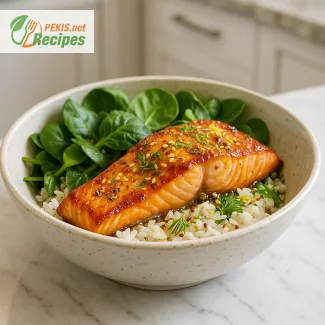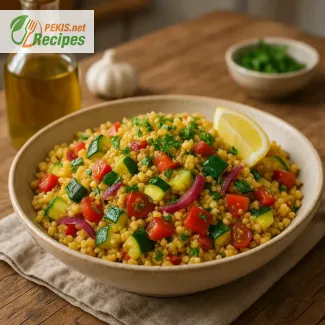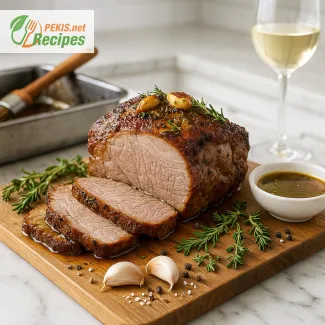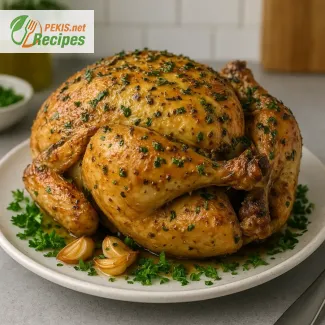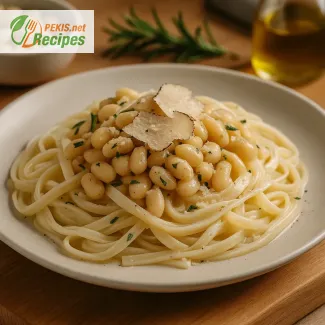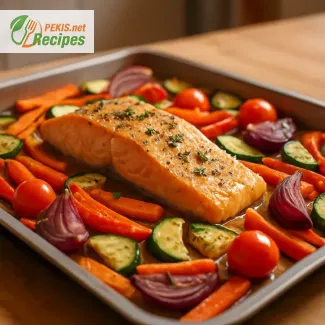
Discover the perfect weeknight meal: Oven-roasted salmon and vegetables
A wholesome, easy-to-make dinner that brings out the best in salmon
When it comes to preparing a healthy and flavorful meal, few dishes strike the balance between simplicity, taste, and nutrition like oven-baked salmon with roasted vegetables. This vibrant combination of tender fish and caramelized, colorful vegetables is not just a culinary favorite—it's a practical solution for anyone seeking nutritious, home-cooked dinners that don't require hours in the kitchen.
Ideal for busy weeknights or casual weekend meals, this dish is anchored by salmon, one of the most nutrient-rich and versatile fish available. Oven-baking the salmon preserves its delicate texture and natural oils, while the high heat of the oven works its magic on the vegetables, intensifying their flavor and adding irresistible crisp edges. Whether you’re cooking for your family or preparing a wholesome solo dinner, this recipe delivers consistently delicious results.
Why salmon and roasted vegetables are the ideal pair
Salmon is a naturally oily fish, which makes it an excellent candidate for oven roasting. As it cooks, it releases flavorful juices that mingle with the seasoned vegetables, enhancing every bite with savory depth. Pairing it with vegetables like carrots, zucchini, bell peppers, red onions, or cherry tomatoes provides not only contrasting textures but also vibrant color and rich phytonutrient content.
The key to success lies in choosing the right combination of vegetables and seasoning them with olive oil, garlic, herbs like rosemary or thyme, and a touch of citrus. The oven heat ensures the vegetables caramelize beautifully without becoming mushy. This creates a balanced plate where every element supports the next, both in flavor and presentation.
A dish that fits into any lifestyle
Whether you're following a Mediterranean diet, cooking for a low-carb lifestyle, or simply want to introduce more fish and vegetables into your meals, this recipe fits seamlessly. It doesn’t rely on heavy sauces or processed ingredients—just fresh salmon, seasonal vegetables, and pantry staples. It's also easily adaptable for those who prefer dairy-free, gluten-free, or paleo-friendly meals.
Busy professionals appreciate how easily this dinner can be prepared in under 40 minutes, while families love the crowd-pleasing nature of the dish. You can adjust the portion size, swap in your favorite vegetables, or even marinate the salmon in advance to boost the flavor with minimal extra effort.
The benefits of oven-baking
Using the oven is not just a convenience—it’s a cooking method that preserves nutrients and enhances taste without extra fat. Oven-baked salmon stays moist and flaky, and you don’t need much oil to achieve perfectly roasted vegetables. Unlike pan-frying, oven roasting allows the ingredients to cook evenly without needing constant attention, making this method ideal for hands-off cooking.
Another advantage is the ease of cleanup. Everything can be arranged on a single sheet pan, reducing post-dinner chores to a minimum. This makes the recipe ideal for meal prepping, allowing you to roast a larger quantity and enjoy leftovers for lunch or dinner the next day.
Seasonal variations to keep things exciting
While the base recipe uses commonly available vegetables, you can adapt it to reflect the seasonal produce in your area. In spring, opt for asparagus, baby carrots, and green beans. In summer, try zucchini, cherry tomatoes, and bell peppers. Autumn welcomes root vegetables like sweet potatoes, parsnips, and Brussels sprouts, while winter is perfect for cauliflower, broccoli, and winter squash.
You can also explore flavor profiles from around the world. For a Mediterranean twist, include olives and a sprinkle of feta cheese before serving. For a Scandinavian touch, add dill and a side of mustard-dill sauce. For a spicy variation, toss the vegetables in harissa or smoked paprika before roasting.
A meal you can trust
This dish isn’t just visually appealing—it’s grounded in simplicity and quality. With just a few ingredients and straightforward preparation, you create a meal that supports a balanced lifestyle without sacrificing taste. Each element—from the flaky salmon to the caramelized vegetables—adds something special to the plate.
Whether you're an experienced cook or just starting your culinary journey, oven-baked salmon with roasted vegetables offers a reliable and rewarding experience every time.
Step 1: Preheat the oven to 200°C (392°F). Line a large baking tray with parchment paper or lightly grease with olive oil.
Step 2: Rinse the salmon fillets and pat them dry. Place them in a shallow bowl and marinate with 15 ml (1 tbsp) of olive oil, lemon juice, minced garlic, salt, and black pepper. Set aside for 15 minutes.
Step 3: While the salmon is marinating, wash and slice the vegetables: cut the carrots into thin sticks, zucchini into half-moons, red bell pepper into strips, and red onion into wedges. Leave cherry tomatoes whole.
Step 4: Place the vegetables in a large bowl. Add 15 ml (1 tbsp) of olive oil, thyme, salt, and black pepper. Toss well to coat.
Step 5: Spread the vegetables evenly on the prepared baking tray. Make space in the center or on top of the vegetables and place the marinated salmon fillets skin-side down.
Step 6: Bake in the preheated oven for 20–25 minutes or until the salmon is cooked through and flakes easily with a fork. Vegetables should be tender and slightly caramelized.
Step 7: Serve immediately, garnished with additional fresh herbs or a wedge of lemon if desired.
Simple tweaks to elevate your oven-baked salmon and roasted vegetables
Small changes that bring big results in flavor, texture, and nutrition
While the classic combination of oven-baked salmon with roasted vegetables is already a nutritious and flavorful dish, even the most trusted recipes can be enhanced with smart adjustments. By refining techniques, exploring ingredient substitutions, and understanding the behavior of each component in the oven, you can turn a reliable dinner into an exceptional culinary experience. Below are practical suggestions that will help you improve the texture, boost the aroma, reduce unnecessary calories, and customize the dish to fit your dietary goals without compromising on taste.
Adding depth: spice blends and citrus profiles
A simple way to enhance this recipe is by introducing custom spice blends. While herbs like thyme and rosemary are commonly used, try incorporating smoked paprika, ground coriander, or sumac to introduce a smoky, citrusy brightness. These additions bring a layered complexity to the salmon without overpowering its natural flavor.
For an extra burst of acidity, consider adding zest from lemon, lime, or orange to the marinade. The zest doesn’t just contribute acidity but also releases fragrant essential oils that enhance the aroma and freshness of the entire dish. A few drops of balsamic glaze after roasting can offer a hint of sweetness and umami contrast, particularly appealing when using root vegetables.
Upgrading the vegetable mix: color, texture, and seasonality
The beauty of this dish lies in its adaptability. Instead of relying only on carrots, zucchini, and peppers, explore seasonal vegetables for a more vibrant and diverse profile. In winter, roasted Brussels sprouts, cauliflower, or parsnips add nuttiness and body. In spring and summer, green beans, asparagus, or eggplant can offer a softer bite and a lighter feel.
To add texture, include a handful of pumpkin seeds or crushed almonds on top of the vegetables during the last 5 minutes of roasting. This provides a crunchy contrast that elevates the mouthfeel of an otherwise soft plate.
Homemade advantages: why fresh matters
Using fresh, high-quality salmon makes a noticeable difference in both taste and texture. Store-bought pre-seasoned fillets may contain additives or excess salt, which can affect moisture retention during baking. Preparing the dish at home ensures control over the amount of oil, salt, and seasoning, which directly influences the final quality and nutritional value.
Fresh vegetables, cut just before cooking, retain more of their natural sugars and fibers, which are responsible for the rich caramelization during roasting. Avoid using frozen vegetables in this recipe unless they’re first thoroughly thawed and drained, as excess water will result in steaming instead of roasting.
Common mistakes and how to avoid them
One of the most frequent issues is overcooking the salmon, which leads to a dry, flaky texture instead of the desired moist and tender bite. The solution is to remove the salmon from the oven once its internal temperature reaches 52–55°C (125–130°F) and let it rest for a few minutes. Residual heat continues cooking the fish gently without drying it out.
Another common error is crowding the baking tray, which prevents proper airflow and browning. Ensure the vegetables are in a single layer, and give the salmon enough space. Using a convection oven or fan-assisted mode can further promote even roasting and better texture.
Skipping the marination step is another missed opportunity. Even a short 15-minute marination significantly improves the salmon’s moisture and seasoning penetration, especially when citrus and olive oil are involved.
Health-focused substitutions and enhancements
If you’re aiming to make this dish even healthier, swap olive oil with avocado oil, which has a higher smoke point and neutral flavor. For added fiber and protein, consider tossing the vegetables with cooked quinoa or lentils before baking, turning this into a complete one-pan meal.
To reduce sodium, use herbal salt substitutes or increase the quantity of acidic elements like lemon juice or vinegar, which boost flavor perception without increasing salt content. You can also reduce oil slightly and compensate by roasting the vegetables on parchment paper, which prevents sticking and ensures even browning.
Those avoiding animal products can substitute salmon with firm tofu or tempeh, marinated in similar citrus-herb blends. This offers a plant-based alternative rich in protein and capable of developing a crispy edge when baked.
Texture control and plating strategies
Consider scoring the skin of the salmon lightly before baking. This helps render the fat and crisp the skin more evenly. For better color and presentation, brush the fillets with a little olive oil before roasting and finish with a quick broil for 1–2 minutes to create a golden top.
Plating also plays a role in perception. Arrange the vegetables in a circular base with the salmon in the center and garnish with microgreens or a drizzle of herb vinaigrette. This small aesthetic upgrade turns a home-cooked meal into a restaurant-quality experience, inviting more engagement and enjoyment from the first glance.
Allergens present in the recipe:
- Fish (salmon)
Gluten-free: Yes
Suggestions to eliminate allergens and gluten:
- For fish allergies, substitute tofu (firm, 600 g) marinated in the same seasoning and bake for 30 minutes.
- Ensure all spices and condiments used are certified gluten-free.
Vitamins and minerals per serving (approximate):
- Vitamin D – 12 µg: Essential for bone health and immune function.
- Vitamin B12 – 4.5 µg: Supports nerve health and red blood cell formation.
- Vitamin A – 620 µg: Contributes to healthy vision and skin.
- Vitamin C – 38 mg: Enhances iron absorption and immune defense.
- Potassium – 920 mg: Regulates fluid balance and muscle contractions.
- Magnesium – 48 mg: Important for energy production and muscle function.
- Iron – 1.8 mg: Necessary for oxygen transport in the blood.
- Calcium – 52 mg: Supports bone structure and muscle movement.
- Phosphorus – 310 mg: Vital for DNA repair and bone health.
Antioxidants per serving (approximate):
- Lycopene – 3.4 mg: Found in tomatoes; supports heart health and protects cells from damage.
- Beta-carotene – 2.1 mg: Derived from carrots and red pepper; helps prevent oxidative stress.
- Anthocyanins – 0.6 mg: Present in red onion; contribute to inflammation reduction.
- Vitamin E – 3.5 mg: From olive oil; protects cell membranes from free radical damage.
